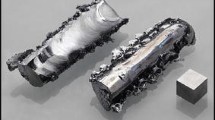Abstract
Cathodic copper is easily contaminated by antimony in copper electrowinning from chloride solutions even when the antimony concentration in the electrolyte is as low as 2 p.p.m. Reduction potential measurements of copper and antimony species indicate that electrodeposition of antimony is unlikely unless copper concentration polarization exists near the cathode surface. A.c. impedance measurements and the effect of the rotation speed of the disc electrode indicate that the cathodic process mechanism for antimony is complicated. Both diffusion and chemical reactions occurring on the cathode surface supply the electrochemical active antimony species for the cathodic process. Reaction orders of the cathodic process with respect to antimony chloride, hydrogen and chloride ion concentrations are 2, −1 and −1, respectively. A proposed reaction mechanism for the process explains the experimental findings satisfactorily.
Similar content being viewed by others
Abbreviations
- A :
-
surface area (cm2)
- ao1, a1 :
-
constants
- C :
-
concentration (mol cm−3)
- D :
-
diffusion coefficient (cm2 s−1)
- E :
-
potential (V)
- F :
-
Faraday constant (Cmol−1)
- f :
-
frequency (s−1)
- I :
-
current (A)
- i :
-
current density (A cm−2)
- i d 8 :
-
limiting diffusion current density due to the diffusion of species O from bulk to the electrode surface and then the subsequent Reac tions 1 and 2 (A cm−2)
- i d o :
-
limiting diffusion current density of species O (A CM−2)
- K :
-
chemical equilibrium constant
- k :
-
rate constant (s−1)
- n :
-
number of electrons involved in the reaction
- Q :
-
charge (C)
- Q dl :
-
charge devoted to double layer capacitance (C)
- Q f :
-
total charge in the forward step of potential step chronocoulometry (C)
- Q r :
-
total charge in reverse step of potential step chronocoulometry (C)
- t :
-
time (s)
- υ:
-
sweep rate (V s−1)
- Γ:
-
amount of species adsorbed per unit area (mol cm−2)
- θ:
-
fraction of adsorption sites on the surface occupied by adsorbate.
- σ:
-
ratio of rate constant defined in Equation 1
- δc :
-
thickness of reaction layer (cm)
- δd :
-
thickness of diffusion layer (cm)
- τ:
-
time (s)
- τ′:
-
modified time (s1/2)
- ν:
-
kinematic viscosity (cm2 s−1)
- ω:
-
angular velocity (s−1)
References
Sumitomo Metal Mining Co., Ltd, Removal of antimony from copper electro-refining bath.Japanese Kokai: Tokkyo Koho JP 57155399 (82155399) 25 Sept. (1982) 4 pp.
Nippon Mining Co., Ltd, Removal of bismuth and antimony from aqueous sulfuric acid acidic solutions,Japanese Kokai: Tokkyo Koho JP 59 208 089 (84 208 089) 26 Nov. (1984) 3 pp.
M. Ishiwatari and E. Kimura, A method for treating a sulfuric acid acidic solution containing antimony and bismuth,Japanese Kokai: Tokkyo Koho JP 62260090 (87260090) 12 Nov. (1987) 3 pp.
D. M. Muir and G. Senanayake, ‘Principles and Applications of Strong Salt Solutions to Mineral Chemistry’, Extraction Metallurgy '86, The Institution of Mining and Metallurgy, London (1985) pp. 65–91.
F. E. Lamb, Hydrometallurgy production of antimony,US Patent 3986943, 19 Oct. (1976) 14 pp.
G. Su, ‘New Hydrometallurgical Process for Antimony’, A Research Report of Hunan Metallurgical Research Institute, China (1981).
X. Xu, D. Zheng and C. Fu, ‘Fundamental Studies on the Hydrometallurgy of Antimony — XPS Studies on Chloride in Explosive Antimony’, Zhougnan Kuangye Xueyuan Xuebao (1987) 18(1), pp. 31.
X. Xu, ‘Mechanism of and Conditions for the Formation of Explosive Antimony’, Master's thesis, Central South Institute of Mining and Metallurgy, China (1984).
R. S. Nicholson and I. Shain,Anal. Chem. 36 (1964) 706.
D. D. MacDonald, ‘Transient Techniques in Electrochemistry’, Plenum Press, New York (1977) pp. 195–201.
V. G. Levich, ‘Physiochemical Hydrodynamics’, PrenticeHall, Englewood Cliffs, NJ (1962).
Z. Tian, Researching Methods of Electrochemistry, Scientific Publisher Sinica, Beijing (1981) pp. 80–102.
Yu V. Pleskov and V. Yu. Filinvskii, ‘Vrasbshayusbshii Diskovyi Electrod’, Izdatel'stva Nauka, Moskova (1972) pp. 74–99.
A. J. Bard and L. R. Faulkner, ‘Electrochemical Methods’, John Wiley & Sons, New York (1980) pp. 535–538.
Author information
Authors and Affiliations
Rights and permissions
About this article
Cite this article
Lin, H.K., Wu, X. & Rao, P.D. Cathodic behaviour of antimony (III) species in chloride solutions. J Appl Electrochem 24, 758–766 (1994). https://doi.org/10.1007/BF00578091
Received:
Revised:
Issue Date:
DOI: https://doi.org/10.1007/BF00578091




